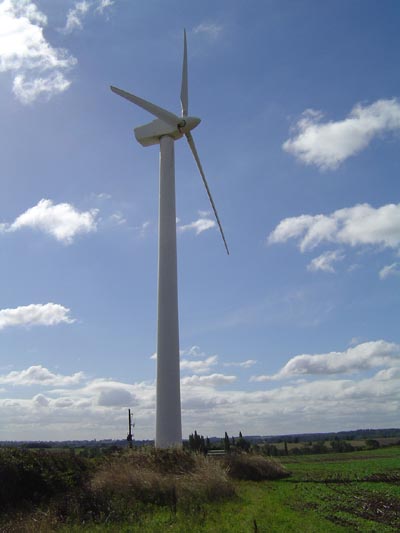A model community energy project
 (Update: 25th March 2013. South Brent successfully completed its fund raising on 22nd March and the turbine will be installed over the next few weeks. Many congratulations to all involved. The outlines of the community ownership scheme should be widely copied elsewhere).
(Update: 25th March 2013. South Brent successfully completed its fund raising on 22nd March and the turbine will be installed over the next few weeks. Many congratulations to all involved. The outlines of the community ownership scheme should be widely copied elsewhere).
A small South Devon community is half way to successfully raising the £420,000 necessary to build a 225 kilowatt wind turbine on farmland at the edge of the parish. Investors are promised a 5% return on their money. The bulk of the income from the turbine over the next twenty years is going to fund future renewable projects in the area, such as micro-hydro installation in another part of the parish as well as much needed home insulation improvements.
South Brent Community Energy Society (SBCES) obtained permission for its turbine almost three years ago. After long negotiations with the suppliers of turbines and agreement with the landowners and power distribution companies, fund raising started in the autumn of last year. To meet the planning conditions, it has until early April to raise the rest of the cash. If you’re interested in the project, please follow the link to the prospectus here. I’m not qualified to recommend the investment, but it does seem to me to be a model of how community energy should work.
South Brent is a few miles from Totnes in Devon, currently the scene of one of the most unpleasant battles between pro- and anti- wind campaigners that the UK has yet seen. The South Brent turbine, by contrast, is broadly supported. [1] There were no objections to the planning permission. It’s to be positioned at a site where the dominant noise will be the A38 trunk road and the nearest house is barely within view. Although not all local residents are happy with the turbine, most seem to be strongly in favour.
Wind speeds were checked on the hilltop site over a period of several years. The average velocity isn’t exceptional for Devon but at 6.0- 6.1 metres per second it’s enough for SBCES to expect to generate at least 320 megawatt hours a year. The local people driving the project - many with an engineering background - seem have been conservative in their projections and their central forecast is based on what is generally called P90, the level of wind output that will be exceeded ninety years out of a hundred.
SBCES is organised as a ‘bencom’, a corporate body that has to have the ‘benefit of the community’ as its core objective. Many similar renewables ventures around the country use this legal structure. A Bencom’s assets cannot be stripped by shareholders and it can only pay a rate of return that is sufficient to stop investors withdrawing their cash. The current directors think that 5% - perhaps rising if inflation continues its apparent upward course – is enough to do this. Any investment now is eligible for the Enterprise Investment Scheme , meaning that UK taxpayers can get 30% of their capital back in tax relief.[2] This raises the implied financial return to over 7%
So far, about 75 people have invested in the scheme. Over 80% are from the parish itself. The average investment is not far short of £3,000, higher than similar fund-raising drives for community projects in other places. For local people, the most important incentive to invest is probably the strong commitment by SBCES to fund energy efficiency improvements to community buildings and reduce fuel poverty. They may also invest some of their profits in other renewable projects, such as a micro-hydro power scheme to run a heat pump for heating the parish church. If the wind turbine achieves the expected average ‘P50’ output, the directors of SBCES anticipate a total of over £700,000 to flow back into the community over the turbine’s life.
Another £200,000 is needed before the 22ndof March if construction is to start before planning permission expires. Please take a look at the prospectus. It seems to me that SBCES, a genuine community project with expert volunteer directors and supporters, is an extremely good model for future small scale energy generation projects.
(Disclosure: I intend to apply for a small number of shares in this project).